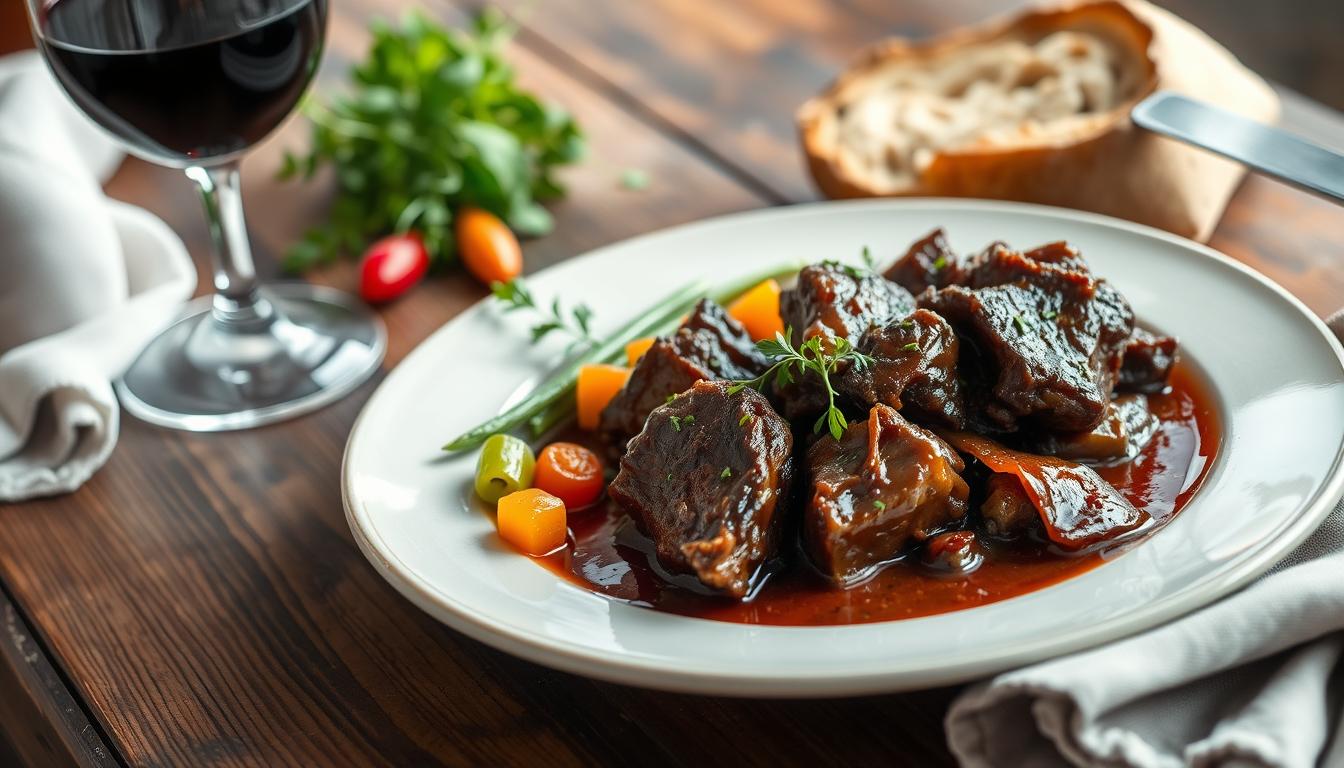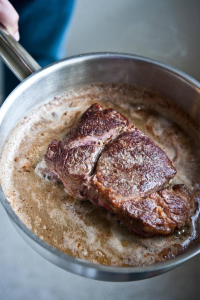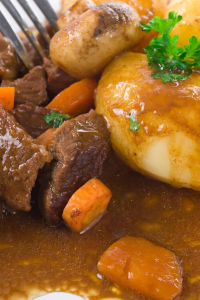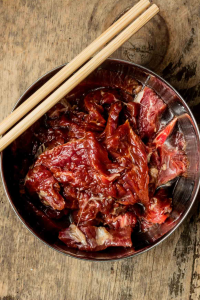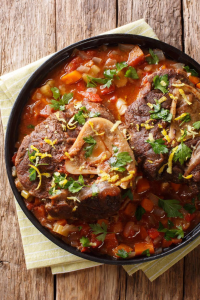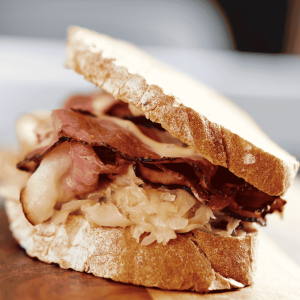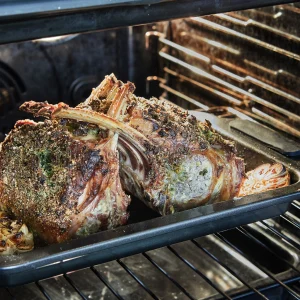Imagine biting into tender, slow-cooked beef cheeks that melt in your mouth. With the right recipe, you can make a dish that’s both tasty and impressive. Recently, 528 people looked for slow-cooked beef cheeks recipes. It’s clear why – this meat can turn into a gourmet meal with little effort.
Whether it’s for a special event or a cozy weeknight dinner, learning to cook beef cheeks is valuable. It’s a skill that can elevate any meal.
Beef cheeks can be cooked in several ways, like slow cooking or braising. A typical serving size feeds 6 people, using either 6 small or 4 large cheeks. You can choose from slow cooking, pressure cooking, or oven baking, depending on your preference.
Slow-cooked beef cheeks are loved for their soft texture and deep flavor. They’re perfect for a special occasion or dinner party.
Key Takeaways
- Beef cheeks can be cooked to perfection using a slow cooker or braising method
- The best beef cheeks recipe typically serves 6 people
- Slow-cooked beef cheeks are tender and flavorful, with a soft texture
- Popular preparation methods include slow cooking, pressure cooking, and oven baking
- Learning how to cook beef cheeks can help you create a gourmet meal with minimal effort
- Beef cheeks can be used in a variety of dishes, from Ragu to pies
- Cooking times for slow-cooked beef cheeks can range from several hours to achieve desired tenderness
Understanding Beef Cheeks: A Cut Above the Rest
Beef cheeks are a special cut of meat, full of collagen. This makes them tender and tasty when cooked slowly. They’re perfect for tender beef cheeks or slow cooker beef cheeks, where you want them to fall apart.
The collagen in them helps keep them moist and sticky. It breaks down well at high heat, so they don’t dry out.
When you think about beef cheeks stew, knowing where they come from is important. They’re from the cattle’s facial muscles, on the sides of their head. This makes them tender and flavorful.
Beef cheeks usually weigh about 200 grams. This size is great for many cooking methods.
Some great things about beef cheeks in your recipes are:
- They have a lot of protein and not much fat
- They’re full of collagen, making them tender and tasty when cooked slowly
- You can cook them in many ways, like slow cooking, braising, and stewing
With the right cooking method, beef cheeks become a delicious dish. Whether you’re making tender beef cheeks, slow cooker beef cheeks, or beef cheeks stew, slow cooking is key. It breaks down the collagen, making them tender and flavorful.
Selecting the Perfect Beef Cheeks
Choosing the right beef cheeks is key for tender and tasty dishes. These cuts are rare, with only two per cow. Look for grass-fed or grain-fed options to impact flavor and tenderness.
Here are important things to think about when picking beef cheeks:
- Average weight: 12 oz to 14 oz (340 g to 400 g) per cheek
- Price: about $14 per lb, with prices going up due to demand
- Nutritional benefits: high in protein (25g per 100g), low in fat (4g per 100g), and zero carbs per 100g serving
By considering these points and picking the right beef cheeks, you’re on your way to a tasty dish. Whether you’re searching for the best beef cheeks recipe or want to master how to cook beef cheeks, the right cut is essential.
| Cooking Method | Cooking Time | Temperature |
|---|---|---|
| Instant Pot | 1 hour 10 minutes | Stew Setting |
| Regular Crock Pot | 6 to 8 hours | Low Setting |
| Oven | 3 to 3.5 hours | 320 °F (160 °C) |
Essential Preparation Steps for Tender Beef Cheeks
To get tender and tasty beef cheeks, you need to prepare them right. Start by trimming and cleaning the meat. Then, use marinating and seasoning techniques. When cooking slow cooker beef cheeks, remove excess fat to avoid a greasy dish.
A beef cheeks stew is a hearty, tasty meal that needs careful prep. Marinate the beef cheeks in herbs and spices to boost flavor and tenderness. For beef cheeks braised in liquid, season the meat well with salt, pepper, and aromatics. This brings out the rich flavors.
- Trim excess fat from the beef cheeks
- Marinate the meat in a mixture of herbs and spices
- Season the beef cheeks generously with salt, pepper, and other aromatics
By following these steps, your beef cheeks will be tender, flavorful, and delicious. This is true for any recipe, like slow cooker beef cheeks, beef cheeks stew, or beef cheeks braised in liquid.
Traditional Braising Method
Cooking beef cheeks the traditional way is a favorite among many. It involves slow cooking the meat in liquid, making it tender and full of flavor. First, heat your oven to 325°F. While it warms up, season the beef cheeks with salt and pepper.
Heat oil in a large Dutch oven over medium heat. Sear the beef cheeks until they’re browned on all sides. Then, set them aside. Next, add onions, carrots, and celery to the pot. Cook until the veggies are tender.
Add a cup of red wine, like Barolo or Barbera d’Alba, and bring to a boil. Put the beef cheeks back in the pot. Cover it and put it in the oven.
After 2-3 hours, the beef cheeks braised will be tender. You can serve them with potatoes or use them in beef cheeks tacos. For a modern twist, try beef cheeks sous vide. Here’s a summary of the nutritional info per serving:
| Nutrient | Amount |
|---|---|
| Calories | 649 kcal |
| Carbohydrates | 18g |
| Protein | 35g |
| Total fat | 35g |
Mastering Slow Cooker Beef Cheeks
To get tender and flavorful slow cooker beef cheeks, knowing about temperature, cooking time, and liquid is key. Cooking beef cheeks stew in a slow cooker is a great way to get tender and tasty results with little effort. When braising beef cheeks, cooking them low and slow is crucial. This breaks down connective tissues, making the meat tender.
For slow cooker beef cheeks, cook on low for 8-10 hours or high for 4-6 hours. The exact time depends on the beef cheeks’ size and thickness, and how tender you like them. Also, the dish gets even better on days 2, 3, and 4, showing the flavor improves over time.
Temperature Settings
The best temperature for cooking slow cooker beef cheeks is between 150°C to 200°C. This range helps break down connective tissues and infuses flavors into the meat. Using a thermometer ensures your slow cooker is at the right temperature.
Cooking Time Guidelines
The cooking time for slow cooker beef cheeks varies based on the meat’s size and thickness, and your desired tenderness. Generally, cook on low for 8-10 hours or high for 4-6 hours.
Liquid Ratios
The liquid ratio for slow cooker beef cheeks is usually 1 part liquid to 2 parts meat. Use red wine, beef stock, and other liquids for a rich sauce. For example, 500ml of red wine and 500ml of beef stock are good for 1kg of beef cheeks.
Here is a sample recipe for slow cooker beef cheeks:
| Ingredient | Quantity |
|---|---|
| Beef Cheeks | 1kg |
| Red Wine | 500ml |
| Beef Stock | 500ml |
| Onion | 2 |
| Garlic | 4 cloves |
| Carrots | 2 |
Sous Vide Beef Cheeks Technique
Cooking beef cheeks sous vide is a special way to make them tender and full of flavor. You seal the meat in a bag and cook it in water. This method cooks the beef cheeks perfectly, making them soft and juicy.
To start, you need to prepare your ingredients. Each beef cheek weighs about 300-400 grams and serves two. Season the cheeks with salt, pepper, and herbs before sealing them in a bag. You can make beef cheeks sous vide with red wine sauce, beef cheeks tacos with Korean flavors, or beef cheeks braised in demiglace.
Here are some key benefits of sous vide cooking for beef cheeks:
- Even cooking: Sous vide ensures that your beef cheeks are cooked consistently throughout, eliminating the risk of overcooking or undercooking.
- Retained moisture: The sous vide method helps to retain the natural moisture of the meat, resulting in a more tender and juicy final product.
- Easy meal prep: Sous vide beef cheeks can be cooked in advance and reheated as needed, making them a great option for meal prep.
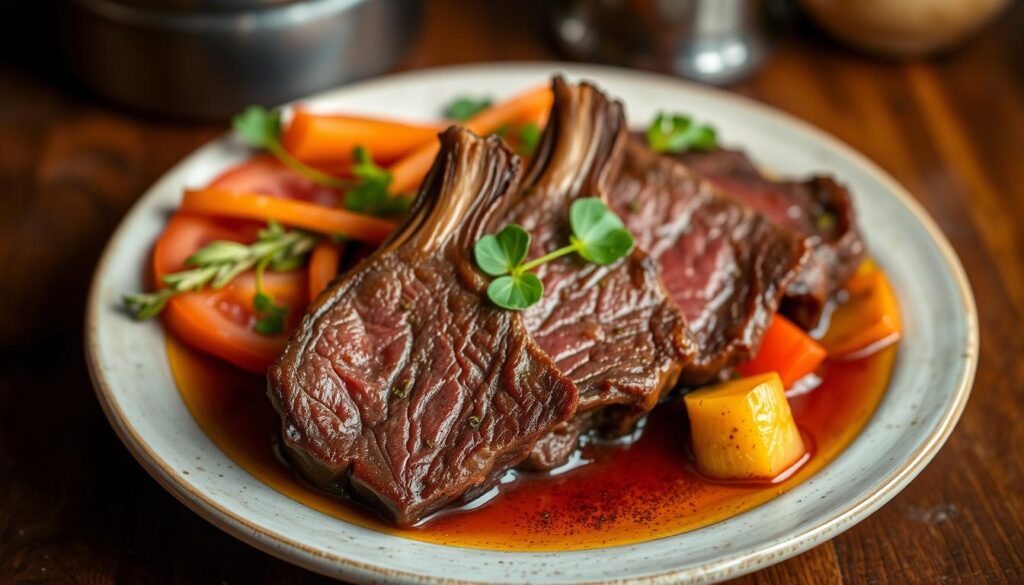
Using sous vide for beef cheeks also requires the right equipment and ingredients. You’ll need a sous vide machine and vacuum sealer. Choose the right cut of meat and seasonings for the best results.
| Temperature | Time | Result |
|---|---|---|
| 180°F (82°C) | 9-12 hours | Braised-like melt-in-your-mouth texture |
| 131°F (55°C) | 48 hours | Steak-like medium-rare |
| 140°F (60°C) | 48 hours | Steak-like medium |
| 165°F (74°C) | 48 hours | Braised-like fork-tender results |
Creating Rich Beef Cheeks Stew
To make a delicious beef cheeks stew, start by picking the right ingredients. You’ll need 3 pounds of beef cheek meat, 4 cups of beef stock, and 1 cup of tomato sauce. Add 2 large carrots and 6 small red potatoes for extra nutrition.
Cooking the stew takes about 2 hours first, then 30 minutes more with the veggies. Make sure the beef reaches 160ºF for safety and tenderness. You can cook it in a slow cooker or oven.
Step-by-Step Process
To make the stew, marinate the beef cheeks for at least 6 hours. Then, cook them in a slow cooker or oven. You can also use a pressure cooker for about 1.5 hours. This way, you get a tender and tasty stew, great with 1 cup of white rice.
Some key ingredients and their quantities are:
- 3 pounds of beef cheek meat
- 4 cups of beef stock
- 1 cup of tomato sauce
- 2 large carrots
- 6 small red potatoes
The stew can be stored in the fridge for 3 days or frozen for 2 months. When reheating, ensure it reaches 160ºF for safety. It’s perfect for a main dish or a sharing meal, ideal for cold winter nights. Both slow cooker and braised methods make the stew delicious and tender.
| Ingredient | Quantity |
|---|---|
| Beef cheek meat | 3 pounds |
| Beef stock | 4 cups |
| Tomato sauce | 1 cup |
| Carrots | 2 large |
| Red potatoes | 6 small |
Transforming Beef Cheeks into Gourmet Tacos
To make tasty beef cheeks tacos, start by cooking the beef cheeks. You can use beef cheeks sous vide or beef cheeks braised. These methods tenderize the meat and add flavor. About 2 lbs. of beef cheeks make 4-5 large tacos or 8-10 smaller ones.
Seasoning is key when cooking the beef cheeks. Use fine sea salt, black pepper, garlic, cumin, and a bit of cayenne pepper. A squeeze of lime juice adds acidity. For extra flavor, top your tacos with Quick Pickled Onions.
Here’s what you need for the Quick Pickled Onions:
- 1/2 large onion, sliced thin
- 1 tablespoon of pickling spices
- 1.5 cups of white vinegar
- 2-3 tablespoons of sugar
After cooking the beef cheeks and making the Quick Pickled Onions, assemble your beef cheeks tacos. Add toppings like sliced radishes, diced tomatoes, and cilantro. The secret to great tacos is balancing flavors and textures. Feel free to try different combinations.
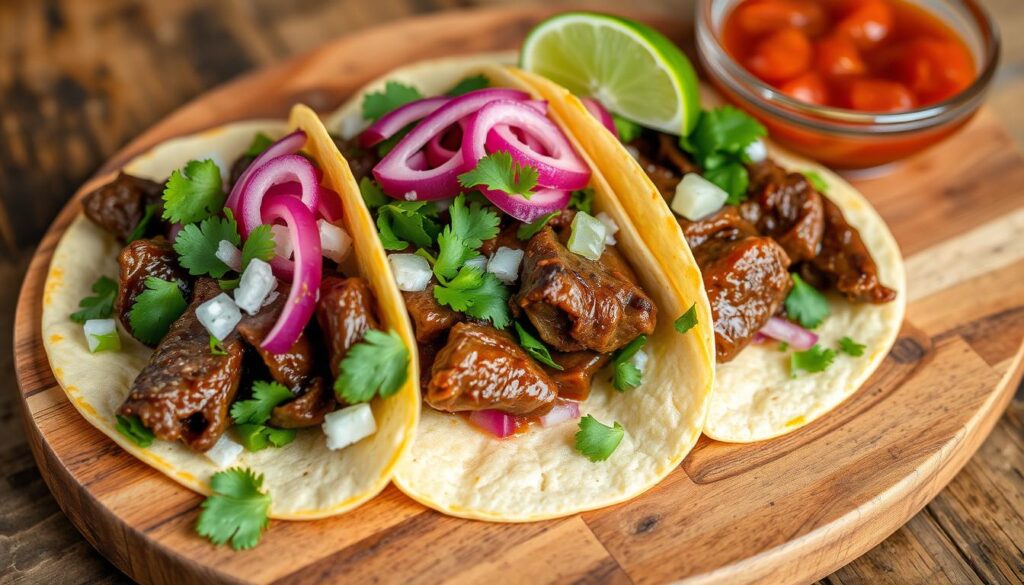
| Cooking Method | Cooking Time | Temperature |
|---|---|---|
| Beef Cheeks Sous Vide | 5.5 hours | 300°F (150°C) |
| Beef Cheeks Braised | 4-5 hours | 275°F (135°C) |
Troubleshooting Common Cooking Issues
When cooking beef cheeks, you might face some common problems. These can mess up the dish’s texture and taste. To get the best results, knowing how to cook beef cheeks and fix these issues is key. One big problem is texture issues, often due to cooking them too little or too long.
Another challenge is making the dish taste better. Adding onions, carrots, and celery can help. A strong marinade also boosts the flavor. Remember, cooking time varies. Slow cookers take 6 to 8 hours, while pressure cookers need about 1 hour and 10 minutes.
Common Cooking Mistakes
- Undercooking or overcooking the beef cheeks
- Not using enough liquid or not covering the beef cheeks during cooking
- Not letting the beef cheeks rest before serving
To avoid these mistakes, stick to a reliable recipe. Use a meat thermometer to check the beef cheeks’ internal temperature. By following these tips, you can make tender and tasty beef cheeks that will wow your guests.
Wine Pairing and Serving Suggestions
Choosing the right wine can make your beef cheeks dish even better. For the best beef cheeks recipe, a fruit-forward red wine is perfect. Californian wines are a top choice for beef cheeks. Here are some great options:
A how to cook beef cheeks guide wouldn’t be complete without wine pairing tips. Here are a few:
- Dry Creek Vineyard Zinfandel “Heritage Vines 2011”
- Louis Martini Cabernet Sauvignon 2010
- Nickel & Nickel Merlot “Suscol Ranch” 2010
- Pujanza Hado, Rioja (Spain) 2010
- St. Francis, Sonoma Valley, Malbec 2010
These wines offer a variety of flavors and prices. This makes it easy to find the perfect match for your beef cheeks. The goal is to find a wine that enhances the rich flavor of the beef cheeks.
By following these wine pairing tips, you can create a memorable dining experience. Whether you’re an experienced chef or new to how to cook beef cheeks, the right wine can elevate your dish.
| Wine | Price | Pairing Suggestions |
|---|---|---|
| Dry Creek Vineyard Zinfandel “Heritage Vines 2011” | $19 | Beef cheeks, braised short ribs |
| Louis Martini Cabernet Sauvignon 2010 | $30 | Beef cheeks, grilled steak |
| Nickel & Nickel Merlot “Suscol Ranch” 2010 | $53 | Beef cheeks, roasted vegetables |
| Pujanza Hado, Rioja (Spain) 2010 | $20 | Beef cheeks, tapas |
| St. Francis, Sonoma Valley, Malbec 2010 | $35 | Beef cheeks, empanadas |
Conclusion: Mastering the Art of Beef Cheeks
Mastering beef cheeks is a rewarding journey. It takes patience, practice, and understanding the meat’s unique qualities. You can choose from braising, slow cooking, or sous vide. The secret to delicious beef cheeks is slow cooking and the right seasonings.
The best beef cheeks recipes let the meat’s natural flavors shine. A good sauce or marinade adds depth. By using the tips from this guide, you’ll cook like a pro. Your family and friends will be impressed.
Keep exploring new flavors and recipes as you get better. Don’t be afraid to try new things. With dedication and a love for cooking, you’ll make dishes that are truly special.
FAQ
What are beef cheeks?
Beef cheeks come from a cow’s cheek muscles. They are tough but full of flavor. Slow cooking makes them tender and juicy.
Why should I choose beef cheeks over other cuts of meat?
Beef cheeks are often overlooked but are great. They’re affordable, packed with protein, and low in fat. Cooked right, they’re tender and tasty.
What are the nutritional benefits of beef cheeks?
Beef cheeks are rich in protein and vitamins like iron, zinc, and B12. They’re also low in fat, making them a healthier choice.
How do I select the best beef cheeks?
Look for deep, rich-colored beef cheeks that feel firm and moist. Avoid dry or discolored ones. Choose between grass-fed and grain-fed for different tastes and cooking times.
What is the best way to prepare beef cheeks for cooking?
Start by trimming fat and sinew. Season with spices and herbs. Marinating helps tenderize and flavor the meat.
What are the benefits of braising beef cheeks?
Braising breaks down tough tissue, making the meat tender. It also creates a rich sauce. The slow heat makes the beef cheeks fall-apart.
How do I cook beef cheeks in a slow cooker?
Slow cooking is great for beef cheeks. Adjust the temperature and time to avoid toughness. Use beef broth or red wine for a tasty sauce.
Can I cook beef cheeks using the sous vide method?
Yes, sous vide is excellent for beef cheeks. It breaks down the tissue for a tender texture. You’ll need special equipment, but it’s worth it.
How can I make a rich and flavorful beef cheeks stew?
Sear the meat for a deep flavor. Then, slow-cook it in a flavorful liquid with veggies and herbs. Simmer for hours to meld flavors and tenderize the meat.
How can I use beef cheeks to make gourmet tacos?
Slow-cook the beef until tender. Shred or chop it, then season. Serve in warm tortillas with your favorite toppings.
What are some common cooking issues with beef cheeks, and how can I avoid them?
Issues include toughness, lack of flavor, and overcooking. Trim and season well, and watch cooking time and temperature. Try different liquids and seasonings for flavor.
What type of wine pairs well with beef cheeks?
Bold red wines like Cabernet Sauvignon, Malbec, or Syrah pair well. The beef’s umami flavors complement the wine’s tannins and fruit notes.

